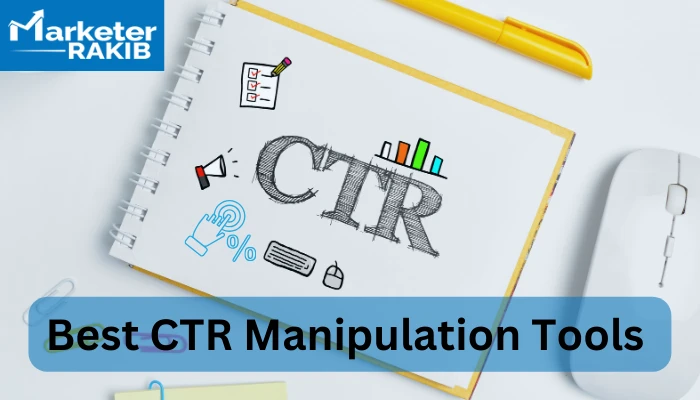The Impact of a CTR Manipulation Press Release on Brand Awareness
The Impact of a CTR Manipulation Press Release on Brand Awareness
Blog Article
How to Gauge the Effect of CTR Adjustment on Your Marketing
Understanding the subtleties of click-through price (CTR) manipulation in advertising is necessary for businesses pursuing authentic customer involvement. By taking a look at essential metrics such as conversion rates and bounce prices, marketing experts can discover possible inconsistencies that might arise from artificial enhancements. Using tools like Google Analytics and applying A/B screening can give understandings into the effectiveness of numerous strategies. However, the ramifications extend beyond immediate data; the long-lasting effects on brand name honesty and individual depend on warrant cautious factor to consider. What stays to be checked out is exactly how these components interconnect and affect total advertising and marketing success.
Understanding CTR Adjustment
Understanding CTR manipulation is necessary for online marketers seeking to maximize their campaigns and make certain information integrity. Click-through rate (CTR) refers to the ratio of users who click on a certain web link to the complete number of individuals who see the advertisement or content.
The implications of CTR manipulation extend beyond mere data distortion; they can threaten count on digital marketing. When organizations depend on inflated metrics, they might buy inefficient campaigns, inevitably harming their return on investment. In addition, systems might punish advertisers taking part in such methods, causing additional ramifications for their advertising initiatives.
To properly combat CTR manipulation, marketing experts need to develop an extensive understanding of their data sources and analytics tools. By using sophisticated monitoring methods and scrutinizing web traffic resources, they can ensure and identify irregular patterns that their performance metrics show genuine user interaction - CTR Manipulation. This alertness is crucial for fostering long-term success in an increasingly affordable electronic landscape
Secret Metrics to Assess
Effective evaluation of vital metrics is essential for reviewing the real performance of advertising projects and finding potential CTR control. One key metric to take into consideration is the Click-Through Rate (CTR) itself, which represents the ratio of customers that click on an ad to the complete number of users that see it. An abrupt spike in CTR may indicate manipulation, necessitating additional investigation.
Additionally, keeping track of conversion prices is important. A high CTR with a low conversion rate could indicate that the clicks are not authentic or that the targeting is misaligned (LinkDaddy CTR Manipulation). Assessing bounce rates can provide understanding right into individual engagement; a high bounce price after a click may recommend that the website traffic is not quality-driven.

Devices for Measurement

Furthermore, A/B testing tools such as Optimizely or VWO can assist in testing with various ad versions to determine which aspects drive higher CTR. These tools permit marketers to assess real-time efficiency and make data-driven changes. Social media analytics devices, like Hootsuite or Sprout Social, can also contribute in comprehending CTR within social systems, providing insights right into audience behavior and engagement patterns.
Moreover, warmth mapping tools, such as Hotjar, can reveal just how individuals engage with ads, helping to identify where renovations can be made. Incorporating these devices develops a durable measurement structure, making it possible for marketing professionals to determine the results of CTR adjustment properly. Eventually, the appropriate selection of measurement tools is important for making educated advertising decisions and optimizing project performance.

Examining Long-term Results
One must take into consideration the long-term results of CTR adjustment on general advertising performance, as short-term gains can often mask much deeper implications. Gradually, synthetically blew up click-through rates might lead to decreased trust fund from consumers and search engines alike. When users repetitively come across deceitful techniques, they may end up being reluctant to involve with the brand, leading to reduced conversion prices in the future.
Furthermore, algorithm updates from platforms such as Google are designed to prioritize authentic engagement over inflated metrics. Consequently, services that count on CTR manipulation might find themselves penalized, causing a decline in natural reach and exposure. This can have a cascading result on brand trustworthiness and consumer loyalty, inevitably threatening the very goals that the initial manipulation sought to achieve.
In addition, the information gathered from controlled CTR may misdirect marketing experts in their approach growth. Counting on manipulated information can lead to misguided projects that fail to reverberate with the target market, causing thrown away sources and missed out on possibilities. It is important for online marketers to assess the lasting implications of CTR control and prioritize sustainable, ethical involvement strategies for lasting success.
Ethical Factors To Consider in CTR Control
In the realm of electronic marketing, honest factors to consider bordering CTR More Info control are critical. While the wish to improve click-through rates (CTR) can result in short-term gains, the possible long-lasting effects on brand name integrity and customer trust can not be neglected. Adjusting CTR usually includes techniques that might misguide users, such as clickbait headings or deceptive advertising and marketing techniques. These approaches can cause a short-term rise in website traffic but may eventually erode consumer confidence.
Furthermore, moral problems include conformity with policies such as the Federal Trade Commission (FTC) standards, which mandate openness in advertising. Failing to stick to these standards can reveal businesses to legal implications and harm their credibility. Marketing professionals need to think about the effects of their approaches on customer experience and the more comprehensive industry landscape.
In addition, the rise of fabricated intelligence and automation in advertising and marketing provides more honest predicaments. Ultimately, honest marketing techniques need to prioritize transparency, sincerity, and regard for the customer, cultivating long-lasting connections that transcend plain metrics like CTR.
Conclusion
In final thought, gauging the impact of CTR manipulation on marketing needs a detailed analysis of key metrics, consisting of click-through prices, conversion rates, and bounce rates. Ultimately, a data-driven technique makes sure that marketing strategies are effective and straightened with authentic customer interactions.
Comprehending the find this nuances of click-through price (CTR) adjustment in advertising and marketing is crucial for businesses making every effort for authentic individual engagement.Effective analysis of vital metrics is essential for evaluating the real efficiency of advertising campaigns and finding possible CTR adjustment.One should think about the long-lasting effects of CTR control on overall advertising performance, as short-term gains can commonly mask deeper ramifications.In the realm of digital marketing, hop over to these guys ethical factors to consider surrounding CTR control are paramount.In conclusion, determining the effect of CTR control on marketing requires a detailed analysis of vital metrics, including click-through rates, conversion rates, and bounce prices.
Report this page